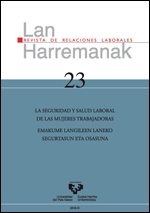De una legislación proteccionista a una normativa neutra en materia de prevención de riesgos laborales
##plugins.themes.bootstrap3.article.main##
##plugins.themes.bootstrap3.article.sidebar##
Abstract
This work attempts to analyse the different regulations issued by diverse authorities (international, EU and national) which have been aimed at regulating the working conditions of women separately from those of men. These regulations are characterised by their protectionist nature. In other words, they have been issued with the aim of protecting the «weakest» subjects on the labour market, i.e. women. This has given rise to the fact that women have not found it at all easy to gain access to employment or to remain in employment. We shall also study what effect the EU Directive has had on equality between men and women, in addition to the jurisprudence of the European Court of Justice in the process of development of all «protectionist» legislation. Lastly, we shall assess the current regulations governing the prevention of risks at work in the light of all the aforementioned.
How to Cite
##plugins.themes.bootstrap3.article.details##
Authors who publish in the journal "Lan Harremanak" do so in agreement with the following terms:
1. Authors retain the copyright of their papers. while ceding to the journal "Lan Harremanak" the right to the first publication of their article.
2. The publisher UPV/EHU Press is a joint copyright holder, in order to protect the legitimate use of the published paper and compliance with CC terms.
3. Published papers are subject to a Creative Commons CC-BY license (unless stated otherwise) which permits third parties to share the paper, on the condition that the author and source are specified when material is reproduced.
4. Authors can enter into other non-exclusive license agreements regarding the published version of their work (e.g. depositing it in an institutional repository or re-publishing it as a monographic volume), providing the author and source are given appropriate credit.
5. Dissemination of submitted articles via Internet is both allowed and recommended (e.g. in institutional repositories and/or on the researcher's web page), both before and during the process of submission, since this can lead to interesting dialogues and also increase citations to the eventual publication.

